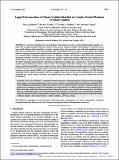Por favor, use este identificador para citar o enlazar a este item:
http://hdl.handle.net/10261/255670COMPARTIR / EXPORTAR:
 SHARE SHARE
 CORE
BASE CORE
BASE
|
|
| Visualizar otros formatos: MARC | Dublin Core | RDF | ORE | MODS | METS | DIDL | DATACITE | |

| Título: | Lagged Teleconnections of Climate Variables Identified via Complex Rotated Maximum Covariance Analysis |
Autor: | Rieger, Niclas; Corral, Álvaro; Olmedo, Estrella CSIC ORCID ; Turiel, Antonio CSIC ORCID | Palabras clave: | Atmosphere-ocean interaction Teleconnections Precipitation Sea surface temperature Empirical orthogonal functions Pattern detection Principal components analysis Dimensionality reduction |
Fecha de publicación: | dic-2021 | Editor: | American Meteorological Society | Citación: | Journal of Climate 34(24): 9861-9878 (2021) | Resumen: | A proper description of ocean–atmosphere interactions is key for a correct understanding of climate evolution. The interplay among the different variables acting over the climate is complex, often leading to correlations across long spatial distances (teleconnections). On some occasions, those teleconnections occur with quite significant temporal shifts that are fundamental for the understanding of the underlying phenomena but that are poorly captured by standard methods. Applying orthogonal decomposition such as maximum covariance analysis (MCA) to geophysical datasets allows us to extract common dominant patterns between two different variables, but generally suffers from (i) the nonphysical orthogonal constraint as well as (ii) the consideration of simple correlations, whereby temporally offset signals are not detected. Here we propose an extension, complex rotated MCA, to address both limitations. We transform our signals using the Hilbert transform and perform the orthogonal decomposition in complex space, allowing us to correctly correlate out-of-phase signals. Subsequent varimax rotation removes the orthogonal constraints, leading to more physically meaningful modes of geophysical variability. As an example, we have employed this method on sea surface temperature and continental precipitation; our method successfully captures the temporal and spatial interactions between these two variables for (i) the seasonal cycle, (ii) canonical ENSO, (iii) the global warming trend, (iv) the Pacific decadal oscillation, (v) ENSO Modoki, and finally (vi) the Atlantic meridional mode. The complex rotated modes of MCA provide information on the regional amplitude and, under certain conditions, the regional time lag between changes on ocean temperature and land precipitation | Descripción: | 18 pages, 12 figures, 2 tables, 2 appendixes | Versión del editor: | https://doi.org/10.1175/JCLI-D-21-0244.1 | URI: | http://hdl.handle.net/10261/255670 | DOI: | 10.1175/JCLI-D-21-0244.1 | ISSN: | 0894-8755 | E-ISSN: | 1520-0442 |
| Aparece en las colecciones: | (ICM) Artículos |
Ficheros en este ítem:
| Fichero | Descripción | Tamaño | Formato | |
|---|---|---|---|---|
| Rieger_et_al_2021.pdf | 3,32 MB | Adobe PDF |  Visualizar/Abrir |
CORE Recommender
SCOPUSTM
Citations
9
checked on 16-abr-2024
WEB OF SCIENCETM
Citations
9
checked on 27-feb-2024
Page view(s)
67
checked on 23-abr-2024
Download(s)
61
checked on 23-abr-2024
Google ScholarTM
Check
Altmetric
Altmetric
NOTA: Los ítems de Digital.CSIC están protegidos por copyright, con todos los derechos reservados, a menos que se indique lo contrario.
